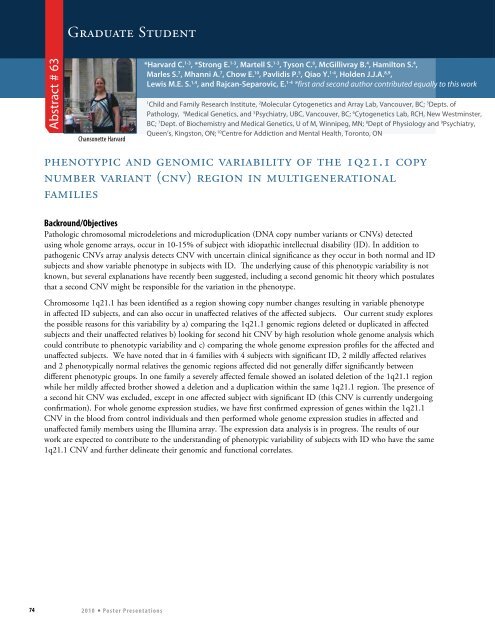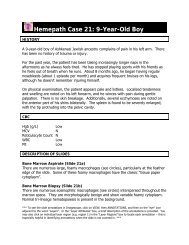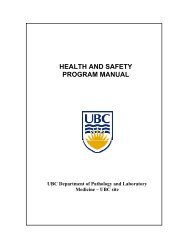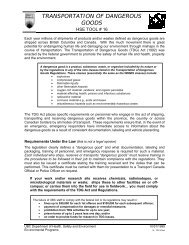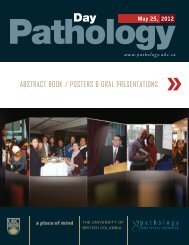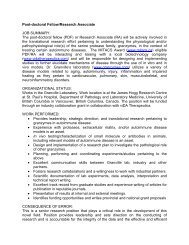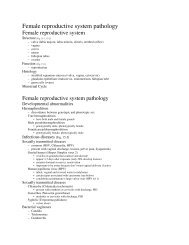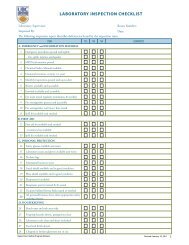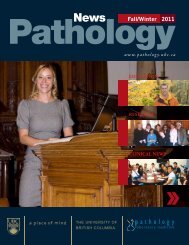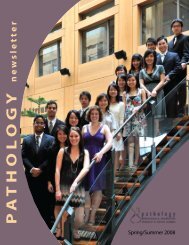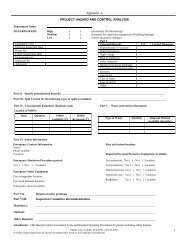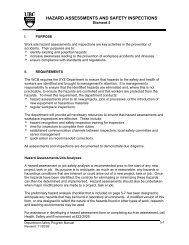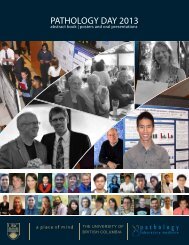Oral Presentations - Pathology and Laboratory Medicine - University ...
Oral Presentations - Pathology and Laboratory Medicine - University ...
Oral Presentations - Pathology and Laboratory Medicine - University ...
Create successful ePaper yourself
Turn your PDF publications into a flip-book with our unique Google optimized e-Paper software.
Graduate StudentAbstract # 63Chansonette Harvard*Harvard C. 1-3 , *Strong E. 1-3 , Martell S. 1-3 , Tyson C. 6 , McGillivray B. 4 , Hamilton S. 4 ,Marles S. 7 , Mhanni A. 7 , Chow E. 10 , Pavlidis P. 5 , Qiao Y. 1-4 , Holden J.J.A. 8,9 ,Lewis M.E. S. 1,4 , <strong>and</strong> Rajcan-Separovic, E. 1-4 *first <strong>and</strong> second author contributed equally to this work1Child <strong>and</strong> Family Research Institute, 2 Molecular Cytogenetics <strong>and</strong> Array Lab, Vancouver, BC; 3 Depts. of<strong>Pathology</strong>, 4 Medical Genetics, <strong>and</strong> 5 Psychiatry, UBC, Vancouver, BC; 6 Cytogenetics Lab, RCH, New Westminster,BC; 7 Dept. of Biochemistry <strong>and</strong> Medical Genetics, U of M, Winnipeg, MN; 8 Dept of Physiology <strong>and</strong> 9 Psychiatry,Queen’s, Kingston, ON; 10 Centre for Addiction <strong>and</strong> Mental Health, Toronto, ONphenotypic <strong>and</strong> genomic variability of the 1q21.1 copynumber variant (cnv) region in multigenerationalfamiliesBackround/ObjectivesPathologic chromosomal microdeletions <strong>and</strong> microduplication (DNA copy number variants or CNVs) detectedusing whole genome arrays, occur in 10-15% of subject with idiopathic intellectual disability (ID). In addition topathogenic CNVs array analysis detects CNV with uncertain clinical significance as they occur in both normal <strong>and</strong> IDsubjects <strong>and</strong> show variable phenotype in subjects with ID. The underlying cause of this phenotypic variability is notknown, but several explanations have recently been suggested, including a second genomic hit theory which postulatesthat a second CNV might be responsible for the variation in the phenotype.Chromosome 1q21.1 has been identified as a region showing copy number changes resulting in variable phenotypein affected ID subjects, <strong>and</strong> can also occur in unaffected relatives of the affected subjects. Our current study exploresthe possible reasons for this variability by a) comparing the 1q21.1 genomic regions deleted or duplicated in affectedsubjects <strong>and</strong> their unaffected relatives b) looking for second hit CNV by high resolution whole genome analysis whichcould contribute to phenotypic variability <strong>and</strong> c) comparing the whole genome expression profiles for the affected <strong>and</strong>unaffected subjects. We have noted that in 4 families with 4 subjects with significant ID, 2 mildly affected relatives<strong>and</strong> 2 phenotypically normal relatives the genomic regions affected did not generally differ significantly betweendifferent phenotypic groups. In one family a severely affected female showed an isolated deletion of the 1q21.1 regionwhile her mildly affected brother showed a deletion <strong>and</strong> a duplication within the same 1q21.1 region. The presence ofa second hit CNV was excluded, except in one affected subject with significant ID (this CNV is currently undergoingconfirmation). For whole genome expression studies, we have first confirmed expression of genes within the 1q21.1CNV in the blood from control individuals <strong>and</strong> then performed whole genome expression studies in affected <strong>and</strong>unaffected family members using the Illumina array. The expression data analysis is in progress. The results of ourwork are expected to contribute to the underst<strong>and</strong>ing of phenotypic variability of subjects with ID who have the same1q21.1 CNV <strong>and</strong> further delineate their genomic <strong>and</strong> functional correlates.74 2 0 1 0 * P o s t e r P r e s e n t a t i o n s


